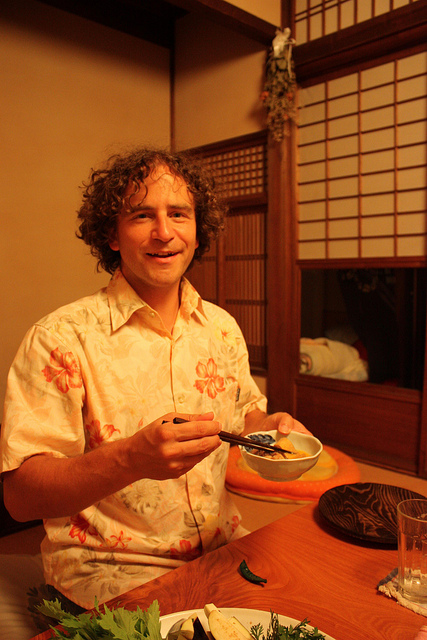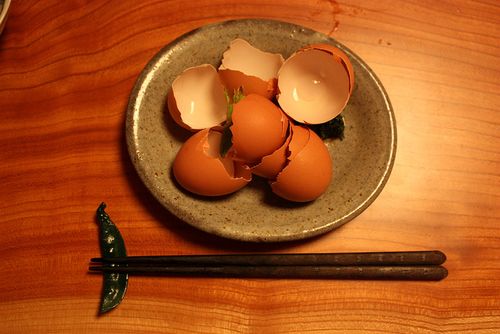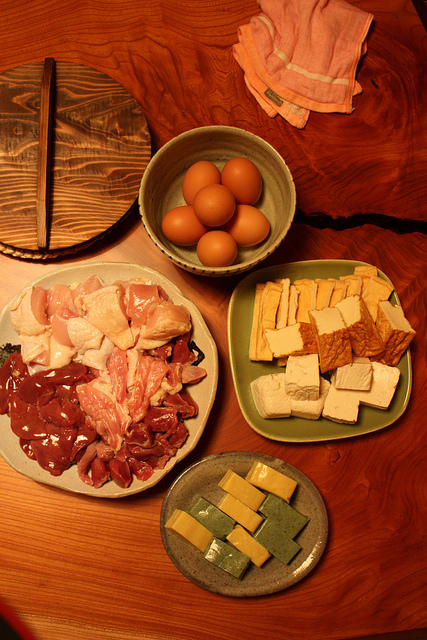
I traveled to Kyoto last week to check out its beautiful temples and delectable foods. Among the people I met was Michael Baxter, an American expat who has lived in Japan for a good 15 years. Kyoto has been his home for over a decade and he is the man behind Kyotofoodie.com, a terrific site on the foodways of Kyoto, once the ancient capital of Japan.
Michael and I first met over a dinner of handmade udon. He then invited me to his home the next evening for sukiyaki to showcase the best of Kyoto’s wealth of vegetables and tofu. Kyoto is famous for its special seasonal vegetables and multicourse meals based on tofu. Really.
He surprised me with a bounty of wonderful goodies – Japanese people are nuts for seasonality. In fact, Masa Fujiwara, a cultural and culinary tour guide in Kyoto, explained to me that it’s (1) important to enjoy foods at their seasonal peak but (2) it’s also good to have things ahead of their seasons so as to prepare one’s body for the seasonal changes ahead.
You can eat it all but stay aware of what lies in front of you. It’s a Zen approach to eating.
Michael lived in an 80-year-old Kyoto style townhouse with tatami rooms filled with rustic charm. He’d already made the broth from dashi (he used a dashi pack made of natural ingredients that he simply steeps for 15 to 20 minutes), shoyu, mirin, and sake.
“Kyoto sukiyaki is on the sweet side. That’s how people like it,” he said.
Then he opened up his smallish fridge, crammed with chicken (skin-on thigh, heart, liver, and gizzard) that he’d salted down to brighten up their flavors. He rinsed and patted down the chicken before cutting it up.
Then we pulled out a bunch of amazing vegetables: Kyoto red peppers, pencil thin carrots, mazutake mushrooms from China, gobo (burdock), eggplant, and mizuna. We also had locally made chewy soft millet and mugwort gluten (called fu, another Kyoto favorite and specialty), fried tofu, and regular tofu. (You can have whatever you want for sukiyaki. Just make sure the ingredients are cut into bite-size pieces.)
Michael knows his Kyoto food traditions but he’s also willing to tinker. He had some deep fried chicken knee cartilage (they’re scrumptious nibbles with beer), and add them to the broth to simmer.

At the table, he placed a portable butane burner and put his sukiyaki pot on top. He then added the cartilage and broth and brought things to a simmer, with the wooden lid on to move things along. Then he strategically added the gobo first because it took longer to cook than the other ingredients. After letting the gobo get a head start, we added some of the chicken and started layering things in the pot.
As things got cooked, we ate. To eat sukiyaki, raw egg is used. You break it into your bowl then add the cooked ingredients from the pot. Stir things around and eat. The egg enriches the cooked ingredients.
I know that the raw egg may seem weird, especially given the salmonella scare recently in the States. But the eggs in Japan are of very high quality and super duper fresh. Michael set out 6 eggs and we ate 5 of them, along with half of the ingredients that you see above.

The leftovers, Michael assured me, would be his breakfast!
It’s not hard to make sukiyaki and Michael approached the evening with a certain organic sensibility, employing the best ingredients possible as they flavor the broth. He’s got a good palate for Kyoto’s food and he taught me lots. Japanese food seems like it’s full of formality but sukiyaki is informal and fun. It’s nosh food that is perfect with lots of sake and beer.
You don’t need a recipe for sukiyaki – just make the broth on the sweet side. Michael actually tinkered with it midway, proclaiming it not sweet enough and he poured in extra sake and sugar! Then put out your raw ingredients, cook, and eat with the raw egg. If you don’t want the raw egg, coddle it first.
I was inspired to start having sukiyaki meals at home. Thanks Kyoto Foodie!
Related links:





















Justin Chen says
I've only done chinese hot pot at home, but sukiyaki looks like it'd be fun to try!
Katy says
Everything is so neat in Kyoto, isn't it? It's interesting that you mentioned Japanese are nuts for seasonality. I think they make the distinct 4 seasons unique to their culture and they celebrate their seasons in good style. Having lived in a place without it for so long, I can well imagine the anticipation, excitement of a new season. Mt Fuji is beautiful and spiritual in all 4 season.
Being a Taiwanese, you know what's missing in that sukiyaki for me - fish balls! Do you find Japanese food blend compared to Chinese/SE Asian's?
Katy says
Everything is so neat in Kyoto, isn't it? It's interesting that you mentioned Japanese are nuts for seasonality. I think they make the distinct 4 seasons unique to their culture and they celebrate their seasons in good style. Having lived in a place without it for so long, I can well imagine the anticipation, excitement of a new season. Mt Fuji is beautiful and spiritual in all 4 season.
Being a Taiwanese, you know what's missing in that sukiyaki for me - fish balls! Do you find Japanese food blend compared to Chinese/SE Asian's?
Katy says
Sorry Andrea, my screen froze when I posted, I must have clicked too many times! Oops, please delete.
KrisD says
I need to move to Japan. I thought I was the only person who loves chicken knees!
Michael B [KyotoFoodie] says
Ohhh, I am on Viet World Kitchen!!
I am really glad that we got to meet up while you were in Kyoto. We got to share two pretty good meals together, udon and then chicken sukiyaki. I also made yuba donburi for Andrea when we did the sukiyaki, and that was really great too.
I hope that you can visit Kyoto again someday.
I can't wait for your new book to come out.
Shox NZ Shoes says
He surprised me with a bounty of wonderful goodies – Japanese people are nuts for seasonality. In fact, Masa Fujiwara, a cultural and culinary tour guide in Kyoto, explained to me that it’s (1) important to enjoy foods at their seasonal peak but (2) it’s also good to have things ahead of their seasons so as to prepare one’s body for the seasonal changes ahead.
Beats by Dr Dre says
Weep no more , no sigh , nor groan. Sorrow calls no time that's gone .